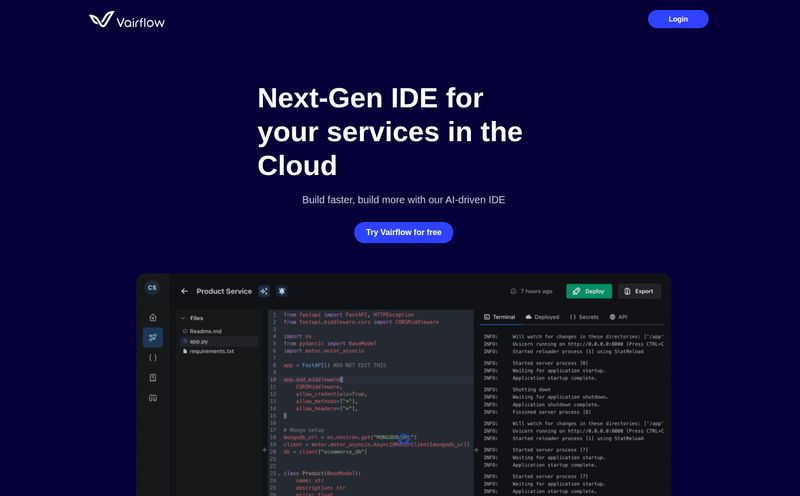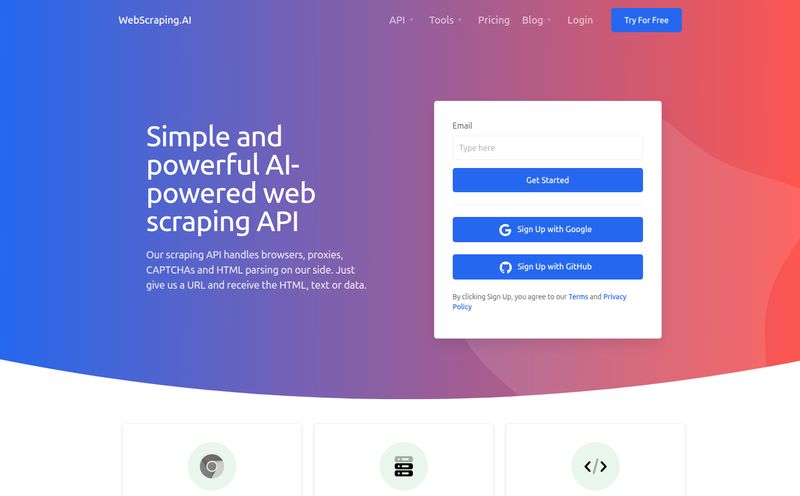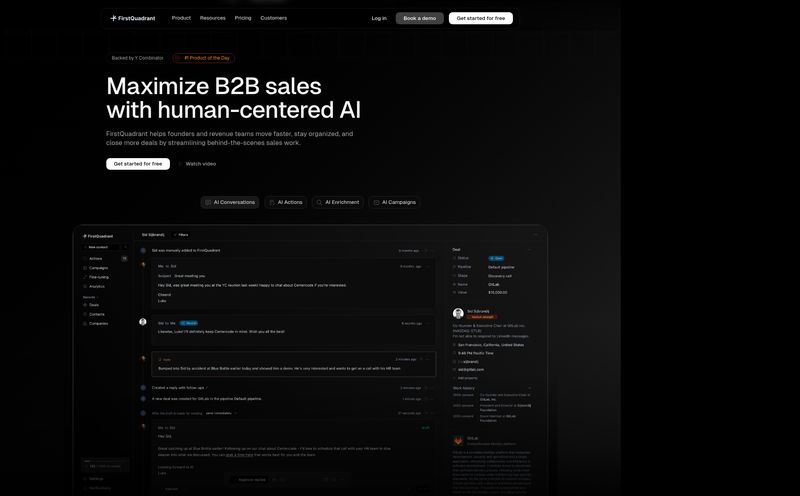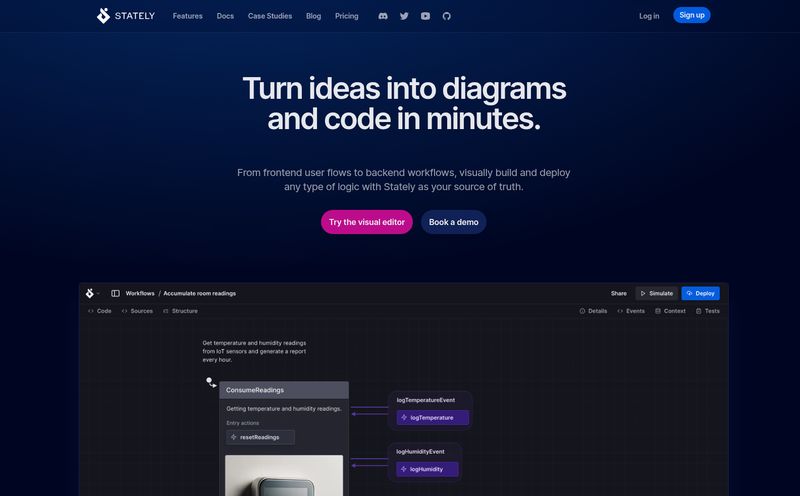Let’s take a little trip back in time. Not too far, just a few years. Remember what it was like trying to bolt AI features onto a new app or service? It was… chaotic. You’d find a great API for text summarization from one company, a decent-but-clunky resume parser from another, and a sentiment analysis tool from a third that had docs written in what felt like an alien language. You ended up juggling three different API keys, three different billing cycles, and three different sets of (often terrible) documentation. It was a mess.
Honestly, it felt like building a car from parts you bought at three different flea markets. Sure, you might end up with something that moves, but it's gonna be rattling all the way down the road.
So when I stumbled across SharpAPI, the tagline “AI-Powered Swiss Army Knife API” immediately caught my eye. A single platform to handle a whole host of AI tasks? That’s the dream, right? But as we all know in the tech world, dreams can quickly turn into over-marketed, under-delivering nightmares. So I decided to take a proper look, to see if this is the real deal or just another shiny object.
So, What Exactly is SharpAPI?
In the simplest terms, SharpAPI isn't one single tool. It's a whole collection of AI-powered endpoints, all bundled together and accessible through a single API. Think of it less like a specialized screwdriver and more like that multi-tool you own that has pliers, a knife, a bottle opener, and that weird hook thing you've never used but are glad is there. It’s designed for developers who want to add sophisticated AI capabilities to their applications without the headache of building the models from scratch.
It’s built to serve a bunch of different industries, which is ambitious. They’re targeting E-commerce, HR Tech, Travel, and even my own backyard, Content and SEO. The whole idea is to provide a one-stop-shop for workflow automation, letting you handle everything from product data to job applications under one roof.
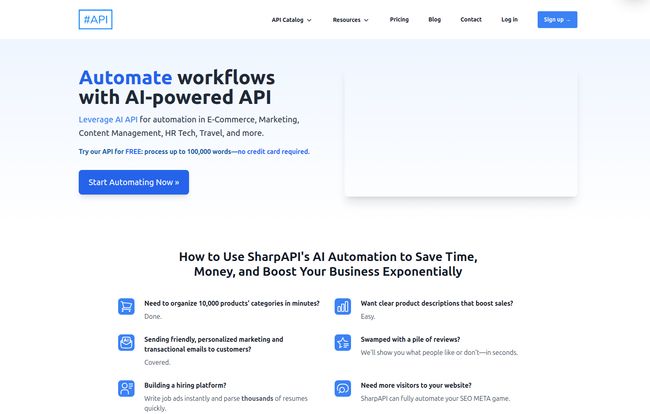
Visit SharpAPI
The Tools in the Toolbox: A Quick Tour of the API Catalog
This is where it gets interesting. A platform is only as good as the tools it offers, and SharpAPI has a pretty wide selection. Instead of just listing them, let's look at how they solve real-world problems.
For the E-commerce Gurus
If you've ever run an e-commerce site, you know the soul-crushing boredom of manual data entry. SharpAPI has a few tools that aim to kill that drudgery. The Product Categorization API is a big one. You can throw a product title or description at it, and it'll spit back a logical category. This is huge for organizing massive inventories. They also have a Product Review Sentiment Checker, which is fantastic for getting a quick pulse on how customers are reacting to a new product without reading thousands of reviews by hand.
For the HR Tech Innovators
Oh boy. I once had to help hire a junior team member and sifted through nearly 200 resumes. By the end, my eyes were crossed and I couldn’t tell a PDF from a Word doc. The Resume/CV Parser API here would have been a lifesaver. It extracts key information—skills, experience, education—into structured data. You can pair that with their Job Match Score and Related Job Recommender to build a seriously efficient recruiting pipeline. This is a massive area for AI, and having these tools ready to go is a huge advantage.
For Content and SEO Pros (My People!)
Naturally, this is the section I was most curious about. And it doesn't disappoint. There’s a Text Summarizer, which is useful for creating snippets or meta descriptions. The Keywords/Tags Generator can help you quickly identify themes in a piece of content, which is great for on-page SEO and content strategy. There’s even a Proofread & Grammar Checker. While I'll always stand by a final human review, using an API to catch the low-hanging fruit can speed up the editing process immensely.
Is It Actually Developer-Friendly? The Nitty-Gritty
A great feature set is useless if it's a nightmare to implement. This is where many platforms fall flat. But SharpAPI seems to have been built by developers, for developers. And that's a good thing.
First off, they provide SDKs for a ton of popular languages. We're talking JavaScript, Python, PHP, Laravel, Flutter, .NET… the gang's all here. This lowers the barrier to entry significantly. You’re not stuck wrestling with raw cURL requests if you don't want to be. The API itself is a standard RESTful format, so it behaves predictably, which any developer will tell you is a blessing.
One of the more impressive features is its multi-language support. Claiming to support over 80 languages is a bold move, and a very welcome one. For anyone building an application for a global audience, this is a massive feature that saves an unbelievable amount of work. The documentation also looks extensive, which is another gold star in my book. There’s nothing worse than a powerful tool with cryptic docs.
Let's Talk Money: The SharpAPI Pricing Model
Ah, pricing. The moment of truth. SharpAPI uses a tiered, credit-based system, which is pretty common for APIs. The mantra is “you only pay for what you use.” Let’s break it down.
| Plan | Price | Best For |
|---|---|---|
| Build | Free ($0/month) | Developers starting a new project or just testing the waters. |
| Launch | $200/month | Production apps with moderate traffic. |
| Scale | $500/month | High-traffic applications that need serious throughput. |
| Enterprise | Custom | Large-scale operations needing dedicated support and SLAs. |
Each plan gives you a certain number of credits, and each API call consumes a certain number of credits. It’s a transparent model, but it’s one you have to watch. If your app suddenly goes viral, you could burn through credits faster than you expect. It's the same reality we face with cloud services like AWS. You get incredible scalability, but you need to set up some monitoring to avoid a surprise at the end of the month.
The Good, The Bad, and The Realistic
No tool is perfect. Let’s be real. So what are the trade-offs with SharpAPI?
On the plus side, the sheer breadth of tools is the killer feature. The convenience of having one API key, one bill, and one set of docs for all these different functions cannot be overstated. It’s a massive time and sanity saver. It's like hiring a whole team of AI specialists without any of the HR paperwork.
Now for the potential downsides. The site and its documentation imply that this is a tool for people who can write code. This isn’t a no-code platform for a marketer to plug directly into a spreadsheet. And you know what? I think that’s a good thing. It’s a professional tool for people building professional applications. It knows its audience.
The reliance on a credit system means you do have to be mindful of your usage. And of course, you’re putting your trust in their AI models. If their categorization model drifts or their parser's accuracy dips, your application's performance is affected. But that’s the fundamental trade-off of using any third-party API—you’re outsourcing the expertise, and you have to trust the expert. For most teams, that's a trade worth making.
Frequently Asked Questions about SharpAPI
How do the credits work?
It's a pay-as-you-go system. You buy a monthly plan which comes with a set number of credits. Every time you make a call to one of their APIs, it uses up some of those credits. More complex tasks might use more credits than simpler ones.
Can I upgrade or downgrade my plan at any time?
Yes, the FAQ on their site confirms that you can change your plan as your needs evolve. This is pretty standard for SaaS platforms and offers good flexibility for growing projects.
What’s the real difference between the paid plans?
Beyond just more credits, the higher-tier plans (Launch, Scale) offer a higher number of API requests per minute. This is critical for scaling. The Enterprise plan adds things like a Service Level Agreement (SLA) and dedicated support, which are essential for mission-critical applications.
Is there a free trial?
Absolutely. The 'Build' plan is effectively a free-to-start plan. It's designed for development and testing, letting you integrate the API and see how it works before committing to a paid subscription. A very smart move.
Who is SharpAPI really for?
It's for developers, tech leads, and product managers who need to integrate various AI-driven features into their software without the massive R&D cost and time of building them in-house. It’s a powerful accelerator.
What happens if an API call fails?
Their FAQ mentions a policy for failed API jobs, suggesting they have a system in place to handle errors, which is reassuring. You’d likely need to check the specifics in their documentation for how to handle different error codes.
Final Thoughts: Is SharpAPI the Right Tool for Your Belt?
After digging through the features, the tech, and the pricing, I'm genuinely optimistic about SharpAPI. It’s not trying to be a magical, one-click AI solution for everyone. It’s a focused, powerful, and well-designed toolkit for the people who actually build our digital world: developers.
It solves a very real, very annoying problem—API fragmentation. By consolidating so many useful workflow automation tools under a single, easy-to-use umbrella, it has the potential to dramatically speed up development cycles. It enables small teams to punch way above their weight, building features that would have once required a dedicated machine learning department.
So, is it the AI Swiss Army Knife it claims to be? I’d say yes. It’s versatile, practical, and has a tool for almost every common situation you'll encounter. If you’re a developer looking to integrate AI into your next project, you owe it to yourself to check it out. It just might be the tool you wish you had years ago. I know I do.
Reference and Sources
- SharpAPI Official Website
- SharpAPI Pricing Page
- The API Economy - Andreessen Horowitz (for context on the importance of API-first businesses)
